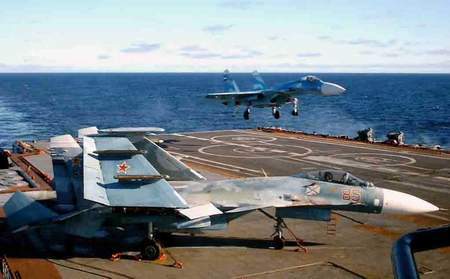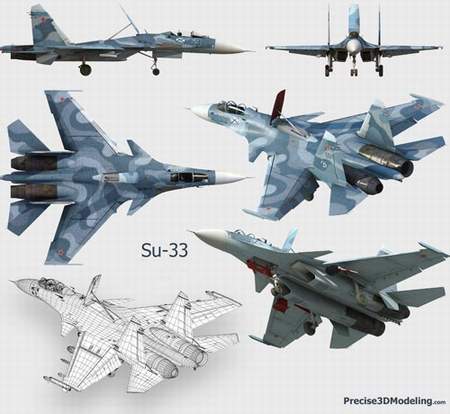The Sukhoi Su-33, also known as the “Flanker-D,” is a naval adaptation of the formidable Su-27 air superiority fighter. Developed by the Sukhoi Design Bureau in the 1980s, the Su-33 was designed to operate from aircraft carriers, providing the Russian Navy with a powerful and versatile fighter capable of projecting air power over vast maritime regions. With its impressive range, advanced avionics, and robust airframe, the Su-33 remains a critical component of Russia’s naval aviation capabilities.

Origins and Development
The development of the Su-33 began in response to the Soviet Navy’s requirement for a carrier-based fighter that could compete with the American F-14 Tomcat. The Sukhoi Design Bureau modified the Su-27, a highly successful air superiority fighter, to meet the unique challenges of carrier operations. The prototype, designated T-10K, first flew in 1987. After extensive testing and refinement, the Su-33 entered service with the Russian Navy in the mid-1990s.

Design and Features
The Su-33 shares many design characteristics with its predecessor, the Su-27, but includes several modifications to enhance its carrier-based performance. One of the most significant changes is the addition of canards, which improve maneuverability and reduce landing speeds—crucial for carrier operations. The aircraft also features strengthened landing gear, an arrestor hook, and folding wings to facilitate storage on crowded carrier decks.
The Su-33 is powered by two Saturn AL-31F afterburning turbofan engines, providing the thrust necessary for short takeoffs from ski-jump ramps found on Russian carriers. The aircraft’s range is extended by the capability to refuel in flight, allowing it to undertake long-range missions over open seas.

Armament and Capabilities
The Su-33 is armed with a variety of weapons, making it a versatile fighter for both air-to-air and air-to-ground missions. Its primary armament includes R-27 and R-73 air-to-air missiles, which provide formidable capabilities in dogfights and beyond visual range engagements. For ground attack missions, the Su-33 can carry guided bombs and air-to-surface missiles.
The aircraft is equipped with advanced avionics, including a powerful radar system capable of tracking multiple targets simultaneously. This radar, combined with an infrared search and track (IRST) system, gives the Su-33 excellent situational awareness and target acquisition capabilities. The cockpit features a modern heads-up display (HUD) and multifunction displays, ensuring that pilots have all the necessary information at their fingertips.

Operational History
The Su-33 has been primarily deployed aboard the Russian Navy’s Admiral Kuznetsov aircraft carrier. Its operational history includes several deployments to the Mediterranean Sea, where it has participated in various training exercises and real-world operations. Notably, the Su-33 played a role in the Russian military intervention in Syria, providing air support for ground forces and demonstrating its versatility and combat effectiveness.
Despite its impressive capabilities, the Su-33 has faced challenges, particularly with the aging and limited availability of the Admiral Kuznetsov. Maintenance issues and the lack of additional carriers have constrained the operational use of the Su-33. However, the aircraft continues to serve as a critical component of Russia’s naval aviation, maintaining a presence in strategic maritime regions.
Modern Upgrades and Future Prospects
To extend the service life and enhance the capabilities of the Su-33, several modernization programs have been initiated. These upgrades focus on improving avionics, increasing weapon compatibility, and enhancing overall performance. The integration of more advanced radar systems and electronic warfare suites is expected to bolster the Su-33’s combat effectiveness in modern conflict scenarios.
Looking to the future, the role of the Su-33 may evolve as Russia continues to develop its naval aviation capabilities. While newer aircraft like the Su-57 and potential carrier-based variants may eventually replace the Su-33, its legacy as a pioneering naval fighter will endure. The lessons learned from operating the Su-33 will undoubtedly influence the design and development of future carrier-based fighters.
Conclusion
The Sukhoi Su-33 stands as a testament to the ingenuity and adaptability of Russian aerospace engineering. Its ability to operate from aircraft carriers, coupled with its formidable armament and advanced avionics, has made it a key asset for the Russian Navy. Despite the challenges faced by Russia’s carrier fleet, the Su-33 continues to demonstrate its value as a versatile and powerful naval fighter. As modernization efforts continue, the Su-33 will remain a critical component of Russia’s maritime defense strategy, ensuring air superiority over the seas for years to come.





